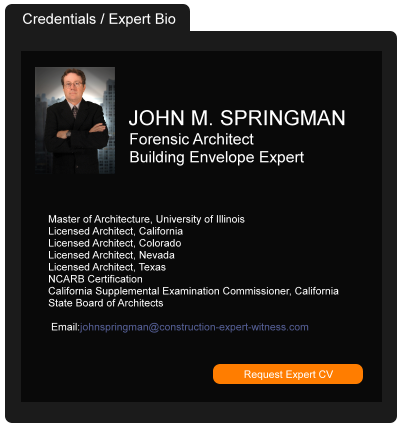Failure to Allege Property Damage Within Policy Period Defeats Insured's Claim
October 03, 2022 —
Tred R. Eyerly - Insurance Law HawaiiThe insured's inability to determine when water damage occurred meant it could not pursue claims of property damage against the insurers. Creek v. State Farm Fire & Cas. Co., 2022 U.S. Dist. LEXIS 116939 (W.D. Wash. July 1, 2022).
Gold Creek Condominium complex experienced water damage. The complex was completed in 1982. The owners sued State Farm and Travelers under all-risk policies when tenders for the damage were denied.
In 2017, Creek hired an expert to investigate deterioration due to water intrusion. The expert noted that "water intrusion had been evident in the exterior walls, soffits, terraces, handrails and elevated entry walkways for some time." Thereafter, Creek tendered claims for property damage to State Farm and to Travelers.
Read the court decisionRead the full story...Reprinted courtesy of
Tred R. Eyerly, Damon Key Leong Kupchak HastertMr. Eyerly may be contacted at
te@hawaiilawyer.com
I-35W Bridge Collapse may be Due to “Inadequate Load Capacity”
January 22, 2014 —
Beverley BevenFlorez-CDJ STAFFThe Crookston Times reports that the I-35W Bridge collapse that occurred five years ago in Minneapolis, Minnesota, killing 13 people and injuring another 145, may have been caused by “inadequate load capacity.” The National Transportation Safety Board (NTSB) report stated that it is “a simple design flaw in metal plates that help connect one steel beam to another.” Due to the findings, “the NTSB set new safety recommendations for bridge design plans, bridge inspection and training of bridge inspectors.”
Read the court decisionRead the full story...Reprinted courtesy of
Las Vegas’ McCarran Tower Construction Issues Delays Opening
August 13, 2014 —
Beverley BevenFlorez-CDJ STAFFThe Las Vegas Review-Journal reported that an improperly applied chemical coating might delay the opening of McCarran International Airport’s Federal Aviation Administration tower by a year and cost millions of dollars to repair.
The chemical coating was intended “to prevent the spread of toxic fungus,” but was “improperly applied and is ineffective,” workers on the site told the Las Vegas Review-Journal.
“Officials said the” $99 million, 352-foot “tower was expected to be operational by 2015, but the FAA now says it won’t be able to use the facility until late 2016 or early 2017.”
Read the court decisionRead the full story...Reprinted courtesy of
Steps to Curb Construction Defect Actions for Homebuilders
June 15, 2017 —
Jason Daniel Feld – Kahana & Feld, LLPThe homebuilding and construction industries in California are at a record high in 2017 according to the National Homebuilders Association. While there is finally prosperity and growth for builders, developers and contractors after suffering from the recession of 2008, there is also a growth in construction defect claims. As with every industry and especially with construction, there are several risk prevention methods that can help curb this litigation.
Time Frames for Pursuing Construction Defect Claims
It is important to know and understand the time frames for which construction defect claims can be pursued by homeowners. There is a hard cut-off for construction defect litigation in California known as the Statute of Repose of 10 years. California Code of Civil Procedure (“CCP”) §337.15 provides a statute of repose that bars actions to recover damages for construction defects more than 10 years after substantial completion of the work of improvement. This provision is limited to property damage claims and does not extend to personal injuries (See, Geertz v. Ausonio, 4 Cal.App.4th 1363 (1992) and willful misconduct or fraudulent concealment claims. (See, Acosta v. Glenfed Development Corp., 128 Cal.App. 4th 1278 (2005).
There are also interim statutes of limitations for “patent” and “latent” defects discovered at the home also from the date of substantial completion. CCP §337.1(e) provides for a four year window to bring suit for deficiencies that are apparent by reasonable inspection (patent deficiencies). CCP §337.15(b) provides for deficiencies that are not apparent by reasonable inspection or hidden defects that require invasive testing to become apparent (latent deficiencies). A latent defect can become patent after it “manifests itself” (i.e. becomes observant – for example a roof leak) for which the four year window from the date of discovery would become the applicable statute of limitations.
The discovery rule effectively acts to toll the statute of limitation period on construction defect claims until they become reasonably apparent. (See, Regents of the University of CA v.Harford Accident & Indemnity, Co., 21 Cal.3d 624, 630 (1978). This is similar to a breach of contract claim, also a four year statute of limitation. Finally, the California Right to Repair Statute (SB800) – Civil Code §§895, et seq. specifically Civil Code §896 sets forth the “Functionality Standards” or a list of actionable defect items, including items affecting the component’s “useful life” and a catch-all provision for all items not expressed listed as defects in the statute. (Civil Code §897). The majority of the defects alleged have a 10 year statute of limitations. However, there are shortened statute of limitations for the following items:
| Functionality Standards | Statute of Limitations |
|---|
| Noise Transmission |
1 year from original occupancy of adjacent unit |
| Irrigation |
1 year from close of escrow |
| Landscaping Systems & Wood Posts (untreated) |
2 years from close of escrow |
| Electrical systems, pluming/sewer systems, steel fences (untreated), flatwork cracks |
4 years from close of escrow |
| Paint/Stains |
5 years from close of escrow |
| All other functionality standards (Civil Code §941(a)) |
10 years after substantial completion(date of recordation of valid NOC) |
Preventative Measures to Curb Construction Defect Litigation
Once the builder knows the time frames for construction defect claims, the following are some preventive measures to limit construction defect claims. As a reminder, homeowners are less likely to bring construction defect action if they feel that the builders are taking care of them.
1. Communicate With Homeowners Prior to Claims
It is imperative to communicate with the homeowners throughout the ten years statute of repose period. For example, most builders provide a limited warranty to the homeowners at the time of purchase. Homeowners are generally confused as to the length of the warranty and what the warranty covers. A practical tip to help curb construction defect claims is for the builder to send postcards or letters to the homeowners at the six month, one year and nine-year marks to advise the homeowner of: (1) the existence of the warranty and what is covered at each time frame; (2) the maintenance obligations of the homeowner at the various time frames; and (3) the fact that the home is approaching the ten-year mark. Most builders would rather deal directly with the homeowners through customer service than defend a construction defect litigation action where the costs to defend the claim will vastly exceed the cost to address the individual homeowner issues. The more the builder communicates with the homeowner in advance, the less likely it is that the homeowner engages in litigation against the builder.
2. Timely Response to Homeowner Claims
During the purchase process, provide the homeowners instructions on how to send in a customer service or warranty requests. Provide multiple methods for notification to the builder by the homeowner when issues arise in their home (fax, email, website forms, etc.). The builder should provide a timely response – within 48 hours of the notice if possible. The homeowner wants to receive some notification from the builder that they received their request and, at the very least, will investigate the claim. Even if it is determined to be a maintenance item or homeowner caused damage, the homeowner should receive: (1) an acknowledgement of the claim; (2) an investigation report of the issue; and (3) an action plan or conclusion statement – this can be a declination of repairs with an explanation as to the cause not being the result of original construction. Sometimes even sending a customer service representative to the home to listen to the homeowner claims and explaining that there are not repairs required is sufficient to satisfy the homeowner. The goal is to make sure the homeowner’s claims are acknowledged and that the builder is standing behind its product. In my experience, the fact that the builder failed to respond in a timely fashion to the homeowner is a significant motivating factor as to why the homeowner elected to enter formal litigation against the builder.
3. Be Proactive When Litigation Ensues Despite the fact that the homeowner has engaged an attorney and joined a construction defect action, the builder is not precluded from continuing to communicate with its homeowners. Several builders send letters to the non-plaintiff homeowners reminding them to contact the builder should they have issues at their homes rather than join the ongoing construction defect action. Under the law, clients can always talk to clients even if they are represented by counsel. While the attorneys for the builders cannot speak to the represented construction defect homeowners, the builder can communicate directly with its homeowners offering to honor its warranty and customer service procedures in lieu of the homeowner proceeding with the litigation. Both of these builder attempts to communicate with homeowners post-litigation have a dual effect – some homeowners elect to contact the builder to effectupate repairs and drop the litigation; while others elect to continue with the litigation. So proceed cautiously in this regard.
It is noted, there are many motivating factors for homeowners to bring a lawsuit against homebuilders that have nothing to do with the construction practices or customer service and are merely economically driven. However, these small steps in addition to providing solid construction practices should help curb construction defect litigation by homeowners.
Jason Daniel Feld is a founding partner of Kahana & Feld LLP, an AV Preeminent boutique litigation firm in Orange County specializing in construction defect, insurance defense, employment and general business litigation matters. The firm was founded with the goal of providing high-quality legal services at fair and reasonable rates. The firm believes that what defines attorneys is not their billing rates, but their record of success, which speaks for itself. For more information, please visit: www.kahanafeld.com.
Read the court decisionRead the full story...Reprinted courtesy of
Largest Per Unit Settlement Ever in California Construction Defect Case?
October 28, 2011 —
CDJ STAFFBusinessWire reports that the Chelsea Court Homeowners Association has settled their construction defect case for $5.4 million. That works out to $169,000 per unit, which BusinessWire describes as “California’s largest per-unit recovery known to be on record to date.”
Most of the money in the settlement is coming from insurance companies for the builder and thirteen subcontractors. Issues included roof and window leaks, deck failures, and unsafe walkways.
Read the full story...
Read the court decisionRead the full story...Reprinted courtesy of
Is Privity of Contract with the Owner a Requirement of a Valid Mechanic’s Lien? Not for GC’s
January 04, 2021 —
Christopher G. Hill - Construction Law MusingsAs any reader of this construction law blog knows, mechanic’s liens make up much of the discussion here at Construction Law Musings. A recent case out of Fairfax County, Virginia examined the question of whether contractual privity between the general contractor and owner of the property at issue is necessary. As a reminder, in most situations, for a contract claim to be made, the claimant has to have a direct contract (privity) with the entity it sues. Further, for a subcontractor to have a valid mechanic’s lien it would have to have privity with the general contractor or with the Owner.
The Fairfax case, The Barber of Seville, Inc. v. Bironco, Inc., examined the question of whether contractual privity is necessary between the general contractor and the Owner. In Bironco, the claimant, Bironco, performed certain improvements for a barbershop pursuant to a contract executed by the two owners of the Plaintiff. We wouldn’t have the case here at Musings if Bironco had been paid in full. Bironco then recorded a lien against the leasehold interest of The Barber of Seville, Inc., the entity holding the lease. The Plaintiff filed an action seeking to have the lien declared invalid because Brionco had privity of contract with the individuals that executed the contract, but not directly with the corporate entity.
Read the court decisionRead the full story...Reprinted courtesy of
The Law Office of Christopher G. HillMr. Hill may be contacted at
chrisghill@constructionlawva.com
Use of Dispute Review Boards in the Construction Process
December 27, 2021 —
Sarah B. Biser - ConsensusDocsDispute Review Boards: Overview
Problems, disagreements and claims arise in most large and complex construction projects regardless of the project delivery method. These disputes can and do delay and significantly increase the cost of the project. Dispute Review Boards, also known as Dispute Resolution Board, Dispute Board, Dispute Avoidance Board or DRB, are often found in large construction projects to assist the parties to minimize, resolve or avoid disputes and mitigate adverse impacts to projects. To date, over $270 billion worth of construction projects have used the dispute review board process to avoid numerous disputes and achieve significant savings.[1]
Unlike mediation and arbitration, a DRB is convened at the very beginning of the project and conducts regular meetings and visits at the project site throughout, allowing the DRB to discuss, observe and monitor construction, progress and potential disputes. At these meetings, DRB members become familiar with many of the facts and acquaint themselves with the job site personnel. If a dispute is submitted to them, the panelists have a great deal of knowledge about the circumstances of the problem to aid them in reaching their recommendations or conclusions. DRBs also encourage open and honest communications among or between the parties during the project, which in turn, encourages avoidance or resolution of disputes before they become formal claims. In short, the DRP process involves real-time discussion of the dispute with highly qualified people who know the particular project from day one and can provide recommendations on how to resolve disputes.
Read the court decisionRead the full story...Reprinted courtesy of
Sarah B. Biser, Fox Rothschild LLPMs. Biser may be contacted at
sbiser@foxrothschild.com
Comparative Breach of Contract – The New Benefit of the Bargain in Construction?
October 26, 2020 —
Steven Hoffman - Florida Construction Law NewsAsk most Florida Construction Law practitioners, and you will likely hear that liability may not be apportioned in “pure” breach of contract cases via the Comparative Fault Act, section 768.81, Florida Statutes (the “Act”). If a material breach is a “substantial factor” in causing damages, the breaching party must answer for all damages that were reasonably contemplated by the parties when they formed the contract. Claimants argue that matters of contract should be governed strictly by the agreement, and risk can be controlled by negotiated terms, including waivers and limitations. Defendants complain that construction projects are collaborative, multi-party affairs, and strict application of contract principles leads to harsh results for relatively minor comparative fault for the same or overlapping damages.
The notion of apportioning purely economic loss contract damages based on comparative fault is not new. Since April 2006, Florida has been a “pure” comparative fault jurisdiction with limited exceptions. Prior to the amendment, tort liability for non-economic damages was purely comparative, but liability for economic damages was typically a combination of joint and several liability with an additional exposure based on comparative fault.
Read the court decisionRead the full story...Reprinted courtesy of
Steven Hoffman, Cole, Scott & KissaneMr. Hoffman may be contacted at
Steven.Hoffman@csklegal.com


































































